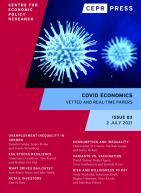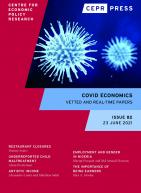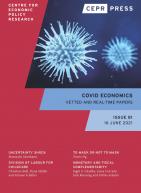
We exploit unexpected changes in the trajectory of pandemics to quantify their effects on aggregate and firm-level stock returns. We find that an unanticipated doubling of predicted infections during the Covid-19 and SARS outbreaks forecasts aggregate equity market value declines of 4% to 11%. Firm returns are sensitive to this information even after accounting for their co-movement with the market, and vary widely both within and across sectors. Our results imply a decline in returns' reaction to new infections as the trajectory of the pandemic becomes clearer.
Citation
Schott, P, A Chari, A Greenland and L Alfaro (2020), ‘Aggregate and Firm-Level Stock Returns During Pandemics, in Real Time‘, COVID Economics 4, CEPR Press, Paris & London. https://cepr.org/publications/covid-economics-issue-4#392514_392880_390379
We study the response of an economy to an unexpected epidemic and we compare the decentralised equilibrium with the efficient allocation. Households mitigate the spread of the disease by reducing consumption and hours worked. A social planner worries about two externalities: an infection externality and a healthcare congestion externality. Private agents’ mitigation incentives are too weak, especially at early stages while the planner implements drastic and front-loaded mitigation policies. In our calibration, assuming a CFR of 1% and an initial infection rate of 0.1%, private mitigation leads to a 10% drop in consumption and reduces the cumulative death rate from 2.5% of the initially susceptible population to about 2%. The planner reduces the death rate to 0.2% at the cost of an initial drop in consumption of around 40%.
Citation
Philippon, T, V Venkateswaran and C Jones (2020), ‘A Note on Efficient Mitigation Policies‘, COVID Economics 4, CEPR Press, Paris & London. https://cepr.org/publications/covid-economics-issue-4#392514_392880_390380
The standard SEIR model based on a parameterisation consistent with the international evidence cannot explain the very high Covid-19-related mortality in Lombardy. This paper proposes an extension of the standard SEIR model that is capable of solving the puzzle. The SEIR model features exogenous mortality: once susceptible individuals are first exposed, and then infected, they succumb with a given probability. The extended model inlcudes a hospitlisation process and the possibility that hospitalised patients, who need to resort to an intensive care unit, cannot find availability because the ICU is saturated. This constraint creates an additional increase in mortality, which is endogenous to the diffusion of the disease. The SEIHCR model (H stands for hospitalisation and C stands for constraint) is capable of explaining the dynamics of Covid-19-related mortality in Lombardy with a paramerisation consistent with the international evidence.
Citation
Favero, C (2020), ‘Why is COVID-19 Mortality in Lombardy so High? Evidence from the Simulation of a SEIHCR Model‘, COVID Economics 4, CEPR Press, Paris & London. https://cepr.org/publications/covid-economics-issue-4#392514_392880_390381
The economic downturn caused by the current Covid-19 outbreak has substantial implications for gender equality, both during the downturn and the subsequent recovery. Compared to 'regular' recessions, which affect men’s employment more severely than women’s employment, the employment drop related to social distancing measures has a large impact on sectors with high female employment shares. In addition, closures of schools and daycare centers have massively increased child care needs, which has a particularly large impact on working mothers. The effects of the crisis on working mothers are likely to be persistent, due to high returns to experience in the labour market. Beyond the immediate crisis, there are opposing forces which may ultimately promote gender equality in the labour market. First, businesses are rapidly adopting flexible work arrangements, which are likely to persist. Second, there are also many fathers who now have to take primary responsibility for child care, which may erode social norms that currently lead to a lopsided distribution of the division of labour in house work and child care.
Citation
Tertilt, M, M Doepke, J Oltead-Ruey and T Alon (2020), ‘The Impact of COVID-19 on Gender Equality‘, COVID Economics 4, CEPR Press, Paris & London. https://cepr.org/publications/covid-economics-issue-4#392514_392880_390382
We combine GPS data on changes in average distance travelled by individuals at the county level with Covid-19 case data and other demographic information to estimate how individual mobility is affected by local disease prevalence and restriction orders to stay at home. We find that a rise of local infection rate from 0% to 0.003%4 is associated with a reduction in mobility by 2.31%. An official stay-at-home restriction order corresponds to reducing mobility by 7.87%. Counties with larger shares of population over age 65, lower share of votes for the Republican Party in the 2016 presidential election, and higher population density are more responsive to disease prevalence and restriction orders.
Citation
Stromme, J, A Zhou and S Engle (2020), ‘Staying at Home: Mobility Effects of COVID-19‘, COVID Economics 4, CEPR Press, Paris & London. https://cepr.org/publications/covid-economics-issue-4#392514_392880_390383
Social distancing is vital to mitigate the spread of the novel coronavirus. We use geolocation data to document that political beliefs present a significant limitation to the effectiveness of state-level social distancing orders. Residents in Republican counties are less likely to completely stay at home after a state order has been implemented relative to those in Democratic counties. We also find that Democrats are less likely to respond to a state-level order when it is issued by a Republican governor relative to one issued by a Democratic governor. These results are robust to controlling for other factors including time, geography, local Covid-19 cases and deaths, and other social distancing orders. We conclude that bipartisan support is essential to maximise the effectiveness of social distancing orders.
Citation
QIU, T and M Painter (2020), ‘Political Beliefs aect Compliance with COVID19 Social Distancing Orders‘, COVID Economics 4, CEPR Press, Paris & London. https://cepr.org/publications/covid-economics-issue-4#392514_392880_390355


Covid Economics - Issue 82
- Restaurant Closures during the Pandemic: A Descriptive Analysis
- Underreporting Child Maltreatment during the Pandemic: Evidence from Colorado
- Covid-19 impact on Artistic Income
- COVID-19, Employment, and Gender: Evidence from Nigeria
- The Importance of Being Earners: Modelling the Implications of Changes to Welfare Contributions on Macroeconomic Recovery
